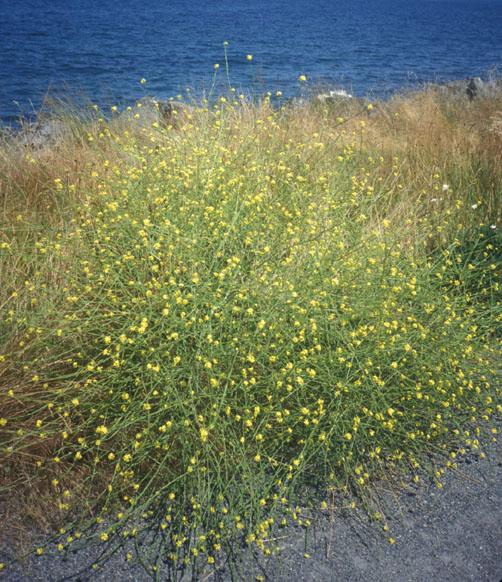
|
| Black Mustard; Brassica nigra (L.) Koch |
Mustard Family; CRUCIFERÆ (BRASSICACEÆ)
|
| People adding mustard sauce to sandwiches or hotdogs are applying a combination of vinegar, flour, and ground seeds from the
Black Mustard plant. Black Mustard is the general species used for this purpose, as well as in several other human applications. |
| While Brassica nigra is known primarily as a seed-producer, some of its kindred are famous for other reasons. The
common Yellow or Field Mustard (Brassica Rapa var. campestris; Weed-of-the-month October 1987) is stunning in its bright yellow bloom,
and makes early spring greens of unparalleled nutrition and fiery flavor. The variable clan of
Brassica also includes such cultivated crops as cabbage, brussels sprouts, cauliflower, kohlrabi, broccoli, kale and collards. Hedge Mustard
(Sisymbrium officinale; Weed-of-the-month August 1992) and other cousins are also members of the large, important mustard family. Most of these plants bear
yellow flowers featuring 4 petals, arranged like an x or cross, whence the Latin term "crucifers" used to refer to them collectively.
Black Mustard is the sixth and last crucifer in our weed article series. It is last because, at least to urban gardeners in our area, it is rather
less important than the five species already dealt with. |
| Black Mustard is an Old World native, long naturalized in North America. It grows in dry, sunny, open fields, along
railroad tracks, in warehouse districts, and poor beat-up places. It is not a backyard garden weed usually. |
| Its yellow flowers are not as showy as those of many other mustard relatives. From April through August they appear, and as
the flowerstems elongate, are succeeded by slender, bumpy, short seedpods held quite tightly erect. The leaves are usually dark green
and raspy. As an edible, they're inferior to most mustard greens, especially raw. |
By late summer, Black Mustard can look spindly, and be much-branched like a tumbleweed. It scatters its seeds, then dies.
The seeds are black, and, as in the parable, are indeed tiny "grainy" affairs. You can gather enough seeds to make your own condiment,
or can try using the plant medicinally. It has been extolled as an acne cure (poultice), hiccups cure (tea), and has other more
serious contributions that herbalists know of. If you
do experiment, proceed with restraint, because mustard oil is powerful and can, if
taken immoderately, cause inflammation.
|
Originally published as the Seattle Tilth newsletter Weed of the Month in April 1994, along with an illustration from a book.
Back |
|
|

